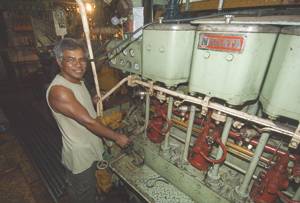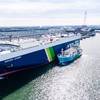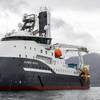Coral Sea: A Good Engineer Knows His Ship
There is an old account of a Chief Engineer, frustrated with his captain’s gold braid and superior attitude, exclaimed, “Look, with out me and my engine this ship won’t go from port to port. I keep the engine running and the propeller turning, all you have to do is make sure that it all stays dry!”
In fact that man had a point and in times past it was not uncommon for an engineer to stay with a ship as it went through various owners. If the Permex Canning company of , ever decided to sell their 167-ft. reefer ship it seems likely that a new owner would want Chief Engineer Bonillo Rafugio to come along with the boat. The Coral Sea has a deep (14.4 ft. molded depth) hull that contains a large engine room space at the bottom of which lurks a venerable six-cylinder Nigata L(MG) 25 BX diesel that can still get up about 1200 hp at just over 600 rpm. Flanking the main engine, a pair of slightly younger 671s powers a pair of 65 kW generators. Forward a pair of compressors, one a 75 hp Mitsubishi and the other a 55 hp Taiwanese-built machine, lurk in the shadows near a massive electrical switch board with knife switches that are more machete than knife.
A darkening patina of rust holds and traps the light from a few bulbs as Rafugio moves with ease down ladders to his familiar lair. After 24 years on the little ship, he is intimate with every pipe and bolt in his engine room. He has been chief for nearly half of the boat’s 58 years since it was launched from a Japanese yard in 1950. Not only does his knowledge of the mechanical intricacies of the engine room make him invaluable, he is one of a rapidly declining group of engineers who are not intimidated by a direct reversing engine and an engine room telegraph. A ship’s bell suspended next to the telegraph control with a speaker tube of dubious age as well supplements the age blackened telegraph relay. But the lever mounted at the front of the engine to shift the cam shaft allowing the engine to be restarted in such a manner that it will turn the crankshaft and in turn the propeller shaft and finally the propeller in the forward or reverse engine that the captain desires.
When she came out of the shipyard over a half century ago, the Coral Sea could make a comfortable 12 knots, today she can, in an emergency, manage ten knots but Refugio prefers to run her at an easy going seven. In a recent trip to deliver 470 tons of frozen tuna from to the owner’s cannery in Zamboanga on in the she managed a steady going seven knots and delivered her valuable cargo in prime condition. As a reward she may get hauled soon to scrape four years growth a barnacles from her hull, which will stop the eerie sounds, like a crackling fire that can be heard in the silent engine room, that the little animals create.













